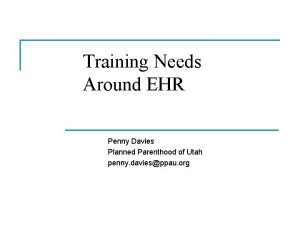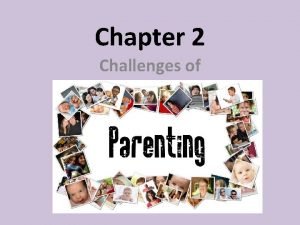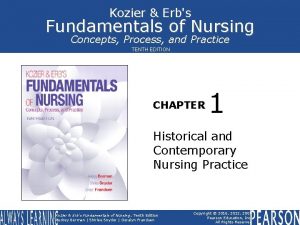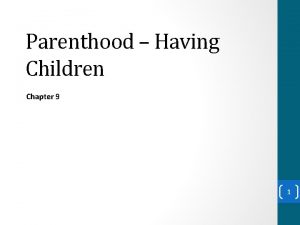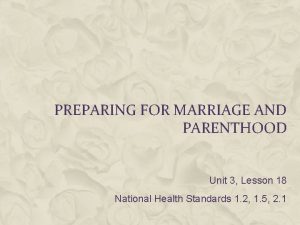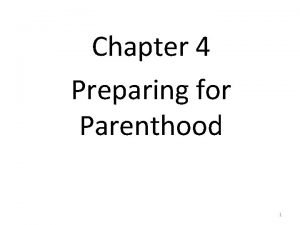Preparing for Parenthood 1 Why is it hard

















- Slides: 17

Preparing for Parenthood 1

Why is it hard to be a good parent? �Children require much care in their first years. They are not able to give much in return. �No age requirement �? ? 2

Deciding About Parenthood �Couples should discuss their feelings about parenthood before they marry. �Permanent choice �A decision NOT to parent is NOT permanent Couples may change their mind in time Young couples have at least 15 safe childbearing years. Adoption is always an option 3

Reasons for Choosing Parenthood �Want to share their love with a child �Wouldn’t it be nice to have a cute little baby? �Our parents want grandchildren �Our older child needs a brother or sister �A child can make us proud �Others will see me as a stable, reliable person �A child will comfort us in our old age �A child will make us love each other 4

Reasons for Not Choosing Parenthood 6% of all couples plan to be childless permanently �We’re not ready for a child �A baby costs a lot �A child will tie us down �A child will interfere with our careers �Our child could be sick or have a disability �Our marriage could fail, and I don’t want to be a single parent 5

How Children Affect Parents Stage Timing of Stage Parenting Task Image-making Before Birth • Prepare for changes in their lives. • Form images of what child will be like and their roles as parents. Nurturing Birth to Age 2 • Try to balance their baby’s needs with their own. • Provide loving and consistent care to their baby. Authority Age 2 to Ages 4 -5 • Change role as the family’s authority figures. • Teach child rules of behavior through reasoning, rewards, and punishment. Interpretive Ages 4 -5 to Ages 12 -13 • Share knowledge about the world with child. • Teach values and morals as the need arises. • Help child understand life isn’t always fair. Interdependent Teen Years • Cope with teen’s changing needs for closeness/distance. • Monitor teens behavior and give guidance. • Give teens more freedom with boundaries. Departure Teen or Early Adult • Evaluate themselves as parents. • Allow child to make own decisions and provide 6 guidance only when asked.

Sharing Responsibilities �What role will each parent play in the family? Husband works and brings home paycheck, wife cares for home and children. Both husband wife work, and children are in childcare. ▪ Husband does more house tasks than traditionally, however wife usually still does more. Wife works and brings home paycheck, husband cares for home and children. 7

Managing Finances �Expenses grow as the child grows. First baby is usually most expensive Additional children increase costs, however they may reuse things from first baby. �Indirect costs: Resources parents use to meet child-related costs that could have been use to meet other goals. (not actual expenses) �Foregone income: Potential income lost by not being in the workforce (stay at home parent) 8

Managing Careers �Maternity leave: a minimum of 6 weeks off. May be paid or unpaid time off depending on employer Many mother return to work after 3 months off, some however take up to a year off. A time for mother to regain her strength, rest and bond with baby �Paternity leave: father helps mother recover and bonds with baby. 9

�Family and Medical Leave Act (FMLA): protects the rights of women and men to take unpaid maternity/paternity leave. Gives workers a total of 12 weeks unpaid leave per year to provide care for family members in certain situations. This law guarantees employees job will still be there when they return from leave. Another law allows mother to take disability pay after childbirth. 10

Family Planning �This happens when a couple decides how many children they want and when to have them. �Birth control methods help make family planning easier than it once was. �Women should see a doctor before becoming pregnant. 11

Infertility and Sterility �About 88% of couples who try to conceive will do so within a year. Couples who do not are known as infertile. Some may need medical assistance. �Sterile: the couple will be permanently unable to conceive or the wife will be unable to carry their fully biological child. 1/3 of fertility problems come from the female, 1/3 is also from the male, the other 1/3 are caused by both partners. 12

What causes fertility problems? �Reproductive diseases �Diabetes �Some prescription drugs High blood pressure meds �Exposure to drugs, chemicals, �STIs �Smoking �Overweight �Excessive physical activity �Aging and radiation 13

Overcoming Infertility �Fertility counseling consists of determining the reasons for fertility problems and exploring treatment options. If a problem is found, hormones or drugs might be given to stimulate ovulation or balance hormone levels. ▪ This may increase females risk of cancers �If that doesn’t work, couples may try assisted reproductive technologies (ARTs), which are methods to help the couple conceive. 14

3 Most Common ARTs: � Artificial insemination: sperm is introduced into the vagina or uterus by a medical procedure rather than sexual relations. Slight risk of infection Not always using husband’s sperm � In vitro fertilization (IVF): some of the mother’s eggs are surgically removed and fertilized with sperm in a laboratory dish. A few days later, the fertilized egg is implanted into the mother’s uterus. (test-tube babies) Risks of surgery Multiple births 15

�Gamete intrafallopian transfer (GIFT): a mixture of sperm and eggs are place in the woman’s fallopian tubes, where fertilization can occur. Because more than one egg is present, conception is more likely, along with a multiple pregnancy. �If pregnancy still fails, couples may use sperm and eggs donated by other people. 16

�Surrogate mother: A woman who bears a child for a couple because female is not able to. She would carry the baby to full term and deliver the baby and sign over parental rights. All of these options are very expensive and sometimes they need to done multiple times with no guarantee or success. 17
 Hey hey bye bye
Hey hey bye bye Planned parenthood ehr
Planned parenthood ehr Family life cycle
Family life cycle Chapter 22 transition to parenthood
Chapter 22 transition to parenthood Medfusion planned parenthood
Medfusion planned parenthood Galinsky's stages of parenthood
Galinsky's stages of parenthood The parenthood decision
The parenthood decision The parenthood decision
The parenthood decision Safe sleep seven
Safe sleep seven Defunding planned parenthood pros and cons
Defunding planned parenthood pros and cons Planned parenthood is done margaret sanger
Planned parenthood is done margaret sanger What makes water hard
What makes water hard Have fun work hard make history
Have fun work hard make history Hard times hard drive
Hard times hard drive Don't ask why why why
Don't ask why why why Kontinuitetshantering i praktiken
Kontinuitetshantering i praktiken Typiska drag för en novell
Typiska drag för en novell Tack för att ni lyssnade bild
Tack för att ni lyssnade bild

